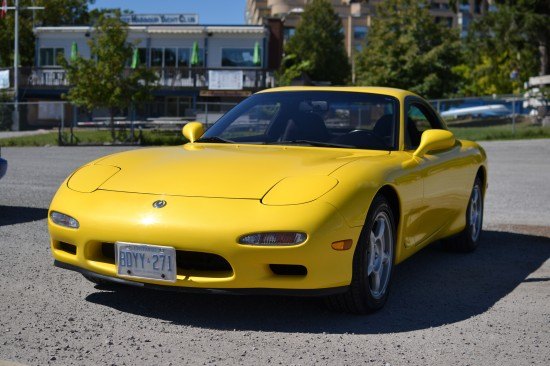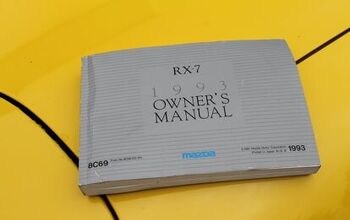Capsule Comparison Part 2: 1993 Mazda RX-7
Deciding what to do with a 662 hp muscle car was hard enough. Deciding what to do with the last pristine nearly new RX-7 in the country is even harder — because you can’t do anything with it, really. You certainly can’t street park it. I left it in an open lot the first night, only to discover that someone had put out their cigarette on the decklid. That was it. I ended up paying prices that would make a Manhattanite blush just so I could leave it in a covered multi-story garage visible from the bedroom window of my condo. Night after night I would stare at the slippery yellow shape under the glow of the cheap halogen lights, like a father staring at his premature baby in the neo-natal unit, checking and re-checking despite the near zero probability of anything bad actually happening.
“We’re having a kegger tonight, if you want to come.”
The text message is from my brother, who was born in November, 1992. The same month and year that this RX-7 was delivered to Mazda Canada. It’s a weekday night and I’d have to drive 125 miles to get there, on an empty, mostly straight highway. But here’s a chance for us to spend some time together, in a car as old as he is, without parents or peers around. It doesn’t happen as often as it should. I throw a change of clothes and my laptop into a bag, then make a beeline for the garage.
My old Miata, shod with slim tires and shaped like a bullet at both ends, lent itself well to being wheeled around parking garages. Not so with the RX-7. The air dam has the same profile and effective clearance as a bulldozer’s blade, and the 255-width front tires mean lots of clenched jaws and bicep work. Exiting the angled ramp of the garage requires popping the door and angling half your body outside the car, Valentino Rossi-style, to make sure you’re not scraping the front end on any curbs.
All of those picayune concerns evaporate once you’re out on the road. The width is still there, but the low hood and near 360 degree glass canopy offers amazing visibility when trying to change lines or dart in and out of traffic. The clutch takeup is beefier than that of the Miata, but has the same intuitive takeup point. Once I’ve escaped the urban hell of rush hour gridlock, the empty highway ramp beckons, and I can finally see what all the fuss is about the rotary engine.
Clarkson likened the Audi R8’s performance to smearing honey inside Keira Knightley, another example of his frequently bestowed, but rarely deserved, superlatives. In the RX-7’s case, the 13B twin-rotor engine really is so smooth, so thrilling and so unlike anything else today that it could accurately be compared to twisting the adjustment knob on Bertel’s favorite adult novelty while it’s inside two of your favorite female celebrities at once. It really is that satisfying.
There is no real perceptible noise or furious forward thrust like that found in a Boss 302 Mustang – in fact, it’s about as fast as a brand new V6 Mustang. Then again a protein bar and a steak can have similar nutritional value. The cable throttle itself is a welcome change from the lifeless servo units in every other car today, and every millimeter of travel translates into a bit of forward thrust that is undeniable and tangible. From 0-4500 rpm there’s a decent shove forward that feels perfectly adequate itself. Once the second, larger turbo comes in, however, there’s a hellfire blast of power, more Tesla than Mazda, and the scenery starts to move very quickly. The 7000 RPM upshift is punctuated with a crisp wastegate ppsshhhtttt and before you know it, you’re at the point of “I really didn’t know how fast I was going, officer”. The RX-7’s effortless ability to warp time and space belies the 255-horsepower rating until you consider that the car weighs 2800 lbs.
And yet before I can non-ironically give this old Mazda a non-ironical “greatest car in the worrrrrld” award, I’m harshly interrupted by its glaring flaws. The seats were apparently designed by the same people who ran the Hanoi Hilton and by mile 75, my lower back felt like it had an awl punched through it, repeatedly. The Bose Acoustic “WaveGuide” stereo also seemed to work on its own schedule; sometimes there would be radio reception, sometimes it would play very well out of one side of the car.
At mile 110, there is a bang and a clunk as the car begins to sag and thump on the driver’s side. Pulling over on the busy 401 freeway isn’t the life-threatening nightmare it usually is, on account of the light traffic at 10 P.M., and there is a Highway Patrolman situated on the shoulder a mere 25 yards behind me. The friendly constable shines a flashlight on the wheel, and it’s apparent that I suffered a full blowout. The sidewall is still attached to the rim, but the rest of the carcass hangs limply off the rim like a badly broken limb. “Holy shit bud,” he says with an almost too stereotypical Canadian accent, “I don’t know how you didn’t end up in the rhubarb.” We are not in Toronto anymore.
The plan is to get the car to my brother’s house on the temporary spare, and somehow get a tire sent down from Mazda HQ. It’s doubtful that the small college town will have the 255/45/16 tire in stock anywhere, so Mazda’s Chuck Reimer agreed to deliver one himself – apparently Mazda has a second RX-7, and they’ll simply borrow a wheel and tire from it to get it there. Of course, the temporary spare has gone flat overnight as well, and a flat-bed truck is now required to get to the dealership just a few miles down the road. It wouldn’t be an RX-7 if things didn’t go wrong.
The next day, after all impediments are removed, the drive back is less eventful. Pouring rain gives way to clear skies. My brother and I pig out on fast food, pour nearly $100 of premium gas in the tank, and stop to get parts for a beer funnel. We curse the poor seats and crappy stereo as he takes in what a car from his birth year was like. He’s incredulous that the RX-7 cost $47,000 Canadian dollars in 1993, roughly $100,000 in today’s money. “You’ve got to be kidding me. With this interior? This is so crappy. I get it on the Miata, but one hundred grand?” The quirks of the car are totally foreign to him too. “I’ve never been in a car that needs to be warmed up and cooled down. Or one where the exhaust gas can get too hot [there’s a warning light for that on the center console].”
We’re in suburbia now, stopped at a long traffic light. The timing is right. “Get out of the car,” I say. “Drive it. You tell me if it’s great or not.”
“Nah, I better not. Don’t want to risk it.”
In truth, I’m tired from the ordeal of the last 24 hours and my back is aching from the uncomfortable seats. My brother is one of the better candidates for this task. He is responsible and dispassionate enough not to test the limits of the RX-7. “It’s ok. You’ve driven my car, you’ve driven the EVO, you’ve driven the Boss and the GT-R. You’ll be fine. And you need some context.”
After the driver change, my brother approaches the car with a mix of joy and trepidation as if he were nervously cradling a newborn. I urge him on. “Go ahead, lay in to it, nothing’s going to happen. My warnings about no traction control and double the power of my Miata may have spooked him.
The smile on his face broadens in time with the sweep of the tachometer needle. “I’ve never felt anything like this before. I love the torque – and I always love a real cable throttle.”
He continues. “I’s like watching sports highlights from the same period. If you watch hockey then versus now, they game is still great, but the players are so much bigger, faster and stronger. It’s weird, because this car is 19 years old – but it’s brand new, and I’m judging it like it’s a new car.”
As he speaks, I’m listening to his argument while examining his technique behind the wheel. For someone who doesn’t live and breathe cars, he drives well. Hands at 9 and 3, steady with his movements, eyes looking well ahead. His friends have all grown up ensconced in marshmallow-soft luxury crossovers loaded with every active safety feature known to man, but he’s been in a few real cars and understands that “sporting” doesn’t just mean a trim level on the BMW X5. Somewhere in the four years that separates us, however, things changed irrevocably and the appeal of an elemental, eccentric sports car faded. At least the driving skills needed to enjoy one have been imprinted on him, should those cars ever return. Fortunately, driving adventures with your loved ones never require context.
More by Derek Kreindler
Latest Car Reviews
Read moreLatest Product Reviews
Read moreRecent Comments
- Kwik_Shift_Pro4X GM is dead to me. Until I rebuy a '96 Chevy Impala SS or '87 Buick Grand National.
- MaintenanceCosts I was last in the RenCen way back in 2011, when a friend of mine got married there. Even at the time, the place seemed very underused.Footnote: I drove a GM product from Washington DC to that wedding and back. It did not get me any apparent special treatment.
- Jeff I doubt most people care. Care more about their vehicles but after being a loyal gm customer for almost 50 years and having family members all the way back to my grandparents I no longer care. The last gm vehicle I owned was 2 years ago. To me gm can go into the dustbin of history.
- Cprescott I'm surprised they didn't move to China. That is who bankrolled their bankruptcy bailout plan.
- Analoggrotto You ask as if I should care. Well I don't. Any more questions?
























































Comments
Join the conversation
Those PZero Neros are are a terrible choice for that car. Totally inferior to the original ones--that were standard on the R2--and the current PZeros.
I had a first-gen RX-7 that I drove for a relatively trouble-free 100K miles. Thrashed it mercilessly to get what power I could. I did yank out the marginal air conditioner, the "thermal reactor" pollution control system, and replaced the point-eating ignition system with an aftermarket electronic upgrade. Synthetic Amsoil lubricants helped with longentivity I suppose.